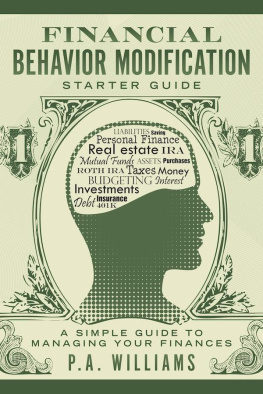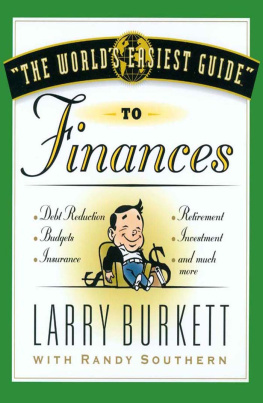P. A. Williams - Financial Behavior Modification Starter Guide: A Simple Guide to Managing Your Finances
Here you can read online P. A. Williams - Financial Behavior Modification Starter Guide: A Simple Guide to Managing Your Finances full text of the book (entire story) in english for free. Download pdf and epub, get meaning, cover and reviews about this ebook. year: 2014, publisher: BookBaby, genre: Home and family. Description of the work, (preface) as well as reviews are available. Best literature library LitArk.com created for fans of good reading and offers a wide selection of genres:
Romance novel
Science fiction
Adventure
Detective
Science
History
Home and family
Prose
Art
Politics
Computer
Non-fiction
Religion
Business
Children
Humor
Choose a favorite category and find really read worthwhile books. Enjoy immersion in the world of imagination, feel the emotions of the characters or learn something new for yourself, make an fascinating discovery.
- Book:Financial Behavior Modification Starter Guide: A Simple Guide to Managing Your Finances
- Author:
- Publisher:BookBaby
- Genre:
- Year:2014
- Rating:3 / 5
- Favourites:Add to favourites
- Your mark:
- 60
- 1
- 2
- 3
- 4
- 5
Financial Behavior Modification Starter Guide: A Simple Guide to Managing Your Finances: summary, description and annotation
We offer to read an annotation, description, summary or preface (depends on what the author of the book "Financial Behavior Modification Starter Guide: A Simple Guide to Managing Your Finances" wrote himself). If you haven't found the necessary information about the book — write in the comments, we will try to find it.
P. A. Williams: author's other books
Who wrote Financial Behavior Modification Starter Guide: A Simple Guide to Managing Your Finances? Find out the surname, the name of the author of the book and a list of all author's works by series.
Financial Behavior Modification Starter Guide: A Simple Guide to Managing Your Finances — read online for free the complete book (whole text) full work
Below is the text of the book, divided by pages. System saving the place of the last page read, allows you to conveniently read the book "Financial Behavior Modification Starter Guide: A Simple Guide to Managing Your Finances" online for free, without having to search again every time where you left off. Put a bookmark, and you can go to the page where you finished reading at any time.
Font size:
Interval:
Bookmark:

ISBN: 9781483530055
Im not an accountant, a lawyer, financial advisor, a tax expert or any other professional of the legal type. This is not financial or legal advice Im offering just my opinion and life experience on personal finance, with that said this E- book contains valuable information to help you understand the essential principles of financial planning. Its purpose is also to serve as a starting point for you on your quest to a fiscally sound and healthy financial life. For detail discussions about successful financial management, also if you find this starter guide to be useful and need more indebt information about personal finance please purchase my book, titled Financial Behavior Modification, which will be released on June 30, 2014. Also visit my website, www.fbm365.com for updates and more information on the concepts and principles of Financial Behavior Modification.
Thank you for your support. I am forever indebted to you for your kindness and for you I am eternally grateful.
THE PLAN
The angle that I will take will be strategically positioned and based on Financial Behavior Modification (FBM). FBM involves making personal changes and assuming personal responsibility for your financial future. It is a common sense approach. This essential guide will help you to develop a well laid-out plan and behavior changing strategies. Personal finance is more about behavior and less about numbers or math.
DEFINE FBM
Financial Behavior Modification is a change in personality or attitude based on new information and experience. Financial Behavior Modification is also a technique to improve financial behavior in everyday life. The unpleasant truth is that making a behavioral change is one of the hardest things that we can set out to do. If change was easy and painless, you would see a lot more successful and happy people walking around. Accepting responsibility for your finances will not be easy. However, it will be truly worth it in the end.
To achieve financial success, you must first change your behavior. You must make a Financial Behavior Modification. You must also have a financial plan. Governments and corporations (small to large) use some type of financial plan to operate successfully. They use this so that they can track what money is coming in and what money is going out.
HOW, WHAT AND WHY
How to get out of debt?
What can you do when you get out of debt?
Why get out of debt?

Of
FINANCIAL BEHAVIOR MODIFICATION
| PRINCIPLE 1: | Layout Short-Term, MidTerm and Long-Term Goals. |
| PRINCIPLE 2: | Gather Personal Financial Information. |
| PRINCIPLE 3: | Prepare a Monthly Budget. |
| PRINCIPLE 4: | Save 3 to 6 Months of Expenses. |
| PRINCIPLE 5: | Pay Down Debt and Repair Credit. |
| PRINCIPLE 6: | Save for/Purchase a Home. |
| PRINCIPLE 7: | Invest in Retirement. |
| PRINCIPLE 8: | Make Smart Purchases of Big Ticket Items. |
| PRINCIPLE 9: | Establish a College Fund. |
| PRINCIPLE 10: | Build Extreme Wealth. |
FIRST THINGS FIRST
Since you have decided to make a change in the financial aspects of your life, lets take a closer look at the Ten Principles of Financial Behavior Modification. We will use the ten principles to lay out a plan to build a strong financial foundation for you and future generations.
The first principle states that you should Lay Out Short-Term, Midterm and Long-Term Goals. You will need to set your short, midterm and long-term goals. It is imperative to use a well-designed process to help you set clear and achievable goals. To facilitate this process, we will use the S.M.A.R.T method for developing goals.
S .M. A . R . T
S.M.A.R.T, is an acronym formed from the initial letters of the words Specific, Measurable, Attainable, Realistic and Timely. In order to achieve financial success, your goals must have all of these attributes. Lets break each one down.
Specific- Your goals should give you a What , Where and Why . You must define what you will do, as well as your desired result. For example, a short-term goal would be as follows: Starting next month and ending in November, I will increase my contributions to my XYZ Bank savings account by $100, in order to fund my Christmas gift-giving activities.
Measurable - Goals must be measurable to ensure success. If goals are not measurable, you cannot track your progress. Goals set successfully will always answer the question, How can I measure my success? In the previous example, you can measure how much can be saved by calculating how much money you would accrue if you began contributing an additional $100 monthly until December.
Achievable - Goals must be achievable. When creating a goal, ask yourself whether you have the resources to achieve the goal. In the example given, it is necessary for you to determine if it is possible to increase your savings by $100 a month. Do you have the financial means?
Realistic - This is perhaps the most important step in successful goal-setting. Realistic goals are practical goals. You must ask yourself Is this goal possible? The goals that you are trying to achieve must also be of great importance to you, so you can stay motivated throughout the process.
Timely- You must have a start time and an end time, so that you can stay focused on your goal and take the necessary steps to reach them. In our previous example, we gave the specific point in time ending in November as the end time and the beginning time is Starting next month.
Now that we have a goal-setting system in place, we will take a closer look at Principle Number One, Lay Out Short-term, Midterm and Long-term Goals. Short-term goals should be goals that you can achieve within the next year. A good example would be to get out of credit card debt, stop accruing debt or buy school clothes. Midterm goals should have a time frame of one year to five years. Example of midterm goals would be saving for an extravagant island vacation. It could also be saving for a down payment on a house or an automobile. In addition, it could be getting out of debt. Long- term goals should be things that you want to achieve over the next five years or longer. An example of a long-term goal would be saving for retirement or saving to fund your childrens college education.
SHORT TERM GOALS (1 year or less)
MIDTERM GOALS (1- 5 years)
LONG TERM GOALS (5 years or longer)
GATHERING PERSONAL INFORMATION
Principle Number Two involves Information Accumulation. It states that you should gather your personal financial information. This is extremely important. It puts you in the perfect place to see all of your debt and all of your income, so that you can adequately plan and prepare your budget. This is also a great opportunity to determine your net worth. In essence, you will learn your financial position-from how much you own to how much you owe.
NET WORTH STATEMENT WORK SHEET
ASSETS
| CASH ON HAND | $____________ |
| CHECKING ACCOUNTS | $____________ |
| SAVING ACCOUNTS | $____________ |
Font size:
Interval:
Bookmark:
Similar books «Financial Behavior Modification Starter Guide: A Simple Guide to Managing Your Finances»
Look at similar books to Financial Behavior Modification Starter Guide: A Simple Guide to Managing Your Finances. We have selected literature similar in name and meaning in the hope of providing readers with more options to find new, interesting, not yet read works.
Discussion, reviews of the book Financial Behavior Modification Starter Guide: A Simple Guide to Managing Your Finances and just readers' own opinions. Leave your comments, write what you think about the work, its meaning or the main characters. Specify what exactly you liked and what you didn't like, and why you think so.












